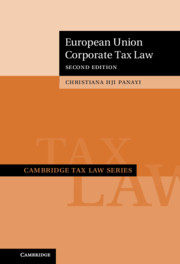Book contents
- Frontmatter
- Dedication
- Contents
- Foreword to the First Edition by Malcolm Gammie QC
- Foreword to the First Edition by Michael Lang
- Foreword to the Second Edition by Philip Baker
- Preface to the First Edition
- Preface to the Second Edition
- 1 A Historical Trajectory of EU Corporate Tax Law
- 2 EU Corporate Tax Legislation
- 3 The Court of Justice and the Development of EU Corporate Tax Law
- 4 Tax Obstacles to the Cross-Border Movement of Companies: Direct Investment
- 5 Tax Obstacles to Cross-Border Portfolio Investment
- 6 Reorganisations under EU Tax Law
- 7 Tax Avoidance and EU Law
- 8 State Aid and Taxation
- 9 EU Corporate Tax Law: More Interim Conclusions and Thoughts
1 - A Historical Trajectory of EU Corporate Tax Law
Published online by Cambridge University Press: 28 May 2021
- Frontmatter
- Dedication
- Contents
- Foreword to the First Edition by Malcolm Gammie QC
- Foreword to the First Edition by Michael Lang
- Foreword to the Second Edition by Philip Baker
- Preface to the First Edition
- Preface to the Second Edition
- 1 A Historical Trajectory of EU Corporate Tax Law
- 2 EU Corporate Tax Legislation
- 3 The Court of Justice and the Development of EU Corporate Tax Law
- 4 Tax Obstacles to the Cross-Border Movement of Companies: Direct Investment
- 5 Tax Obstacles to Cross-Border Portfolio Investment
- 6 Reorganisations under EU Tax Law
- 7 Tax Avoidance and EU Law
- 8 State Aid and Taxation
- 9 EU Corporate Tax Law: More Interim Conclusions and Thoughts
Summary
In Chapter 1, the inherent limitations in the powers of the EU institutions to enact legislation in the field of direct taxes were discussed. The lack of Union competence in this area and the sensitivity of Member States to any attempts for harmonisation were identified as the main reasons for the scarce legislation. Chapter 1 also considered the historical background to some of the legislative proposals for the removal of tax obstacles in the cross-border movement of companies.Proposals for harmonisation were followed by proposals for coordination and ad hoc targeted measures. These led to piecemeal legislative solutions and soft law. It was explained how with the advent of the BEPS project, the Commission produced various legislative proposals, most of which were very protective of Member State tax bases. The soft law initiatives also proved very important, as they laid the ground for the creation of a common external fiscal policy, even in the absence of a common internal fiscal policy. This has proven to be a springboard for further developments, as shown from recent developments and the Brexit discourse.
- Type
- Chapter
- Information
- European Union Corporate Tax Law , pp. 1 - 34Publisher: Cambridge University PressPrint publication year: 2021



